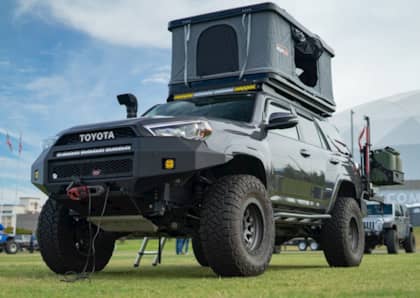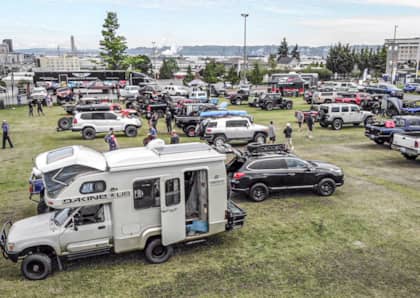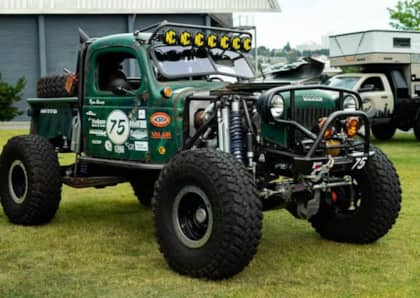5 Most Useful Vehicle Camping Mods For Overlanding in the Pacific Northwest
How you prepare for your next overlanding expedition usually relates specifically to which region of the country you'll be traveling through. Mountains, deserts, forests, and swamp country all have their own unique requirements for making the most of your time out in the wilderness, and it’s important to know what you'll be up against beforehand so you can get your rig ready to go.

Here's a look at 5 of the most useful mods you can make to your truck, SUV, or crossover when overlanding in the Pacific Northwest.
Bumper Winch
Trails in the Pacific Northwest are hit with significant amounts of precipitation every year, which means they have a propensity to wash out more so than other areas of the country. That same rain and snowmelt can also carve trenches across a trail surface, or create soft conditions that lead to significant ruts, posing a challenge to drivers trying to make it safely across.

Being able to self-recover when overlanding far from civilization can mean the difference between a fun weekend and an expensive, time-consuming tow. If your rig is capable of mounting a bumper winch, then that's something you should definitely consider as a useful upgrade prior to a PNW overlanding trip. If you're trekking out in a crossover without a steel bumper for a winch mount, then consider installing tow hook extensions that make it easy to hand-winch or ratchet yourself out of a sticky situation.
All-Terrain Tires
Of course, one of the best ways to avoid getting stuck is to make sure your vehicle is shod with the right tires for dealing with soft, potentially muddy conditions. Here crossover drivers don't have to feel left out, as all-terrain options like the Nitto Nomad Grappler provide the kind of aggressive tread and strong sidewall necessary to handle more difficult driving conditions.

Why choose an all-terrain tire over a traditional all-season tire when overlanding in the Pacific Northwest? Those same slippery trails can also easily conceal rocks that may be more than a match for the lighter construction of an all-season tire. For larger rigs, moving to a dedicated all-terrain tire like the Nitto Recon Grappler is a no-brainer for any expedition in this part of the country, as the peace of mind from the added traction and puncture resistance is well worth the investment.
Auxiliary Lighting
Remember all that precipitation we mentioned earlier? It doesn't just affect that trail surface. The Pacific Northwest is famous for both its rain and its cloud cover, and in combination those two features can have a serious impact on visibility while overlanding. It's also deeply forested, which means you can't count on open, starlit vistas or a bright shining moon if you should happen to be in transit after nightfall.

As a result, stock lighting is often insufficient to keep drivers safe and comfortable when driving through the mountainous region, particularly at higher elevations where clouds can manifest as a fog that surrounds trails and camps. Seeking out auxiliary lighting systems that will help penetrate below fog cover so you can keep tabs on what the terrain ahead looks like is crucial, but it's also worth investing in lighting that can be used to brighten up your campsite once you've pulled off the trail.
Waterproof Rooftop Tent
Given the chance that the ground will be wet and soggy, you'll want to do you best to stay off of it when settling in for the night. If you're sleeping inside your overlanding rig then you've likely already taken the necessary steps to prevent rain and moisture from seeping in through an open window, but if you're looking to camp it's worthwhile to invest in a platform tent that will allow you to sleep either on top of your vehicle or in its cargo bed, rather than simply use a tarp or other protective structure attached to your truck.

The extra elevation will stop you from discovering any new rivers or streams making their way under your campsite at night, and will also help keep your gear clean and out of the mud and muck in the morning.
On-Board Air Compressor
It goes without saying that a full-size spare is well worth bringing along on any overlanding trip. Having the ability to deal with a flat out on the trail is key, and while a tire patch kit can repair most tread-related punctures, a sidewall tear is really going to ruin your day.

Less common to pack is an on-board air compressor. Soft driving conditions can often require you to air down your tires in order to better make your way across a potentially unstable stretch of trail. Once on the other side, the ability to rapidly air up again can save you time and hassle, especially if the weather happens to be particularly unpleasant. Portable air compressors are great, but the higher output of an on-board system is a true off-road luxury.











